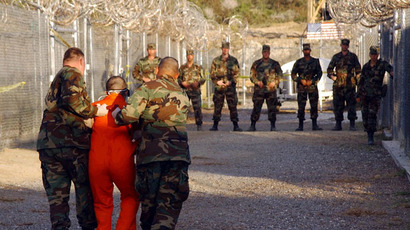Best served with olive oil: Gitmo staffer describes force feeding to RT
A Guantanamo employee in charge of force feeding at the facility told RT correspondent how exactly the inmates ‘like’ the procedure to be performed. 15 of the detainees are reportedly still being force fed at the detention center.
While reporting from inside Guantanamo Bay prison, RT’s Anastasia
Churkina, was able to film in Camp Delta, which houses a hospital
where in additional to medical procedures patients are force fed.
While lawyers and human rights groups condemn the procedure as
inhumane and cruel, a Gitmo employee, who showed the RT crew
around the force feeding room, did not share that attitude,
saying that he never heard from his patients that it was painful.
He actually described how the Gitmo detainees “liked” the
procedure to be done.
“Before it [the force feeding tube] is passed down the nose,
we lubricate it, and we give the patient a choice: do they want
lidocane, which is an agent that will numb the area - or if they
want olive oil to lubricate the tube. Most of our patients have
been using olive oil. They seem to like it. Some of our patients
are so used to it, they will describe which nostrils they
want,” the staffer, who could not have his identity
disclosed, said.
Ramzi Kassem, a Gitmo detainee lawyer, based in New York, is
questioning this optimistic outlook on force feeding.
“The force feeding that my clients have experienced at
Guantanamo, they’ve certainly described it as torture. The
restraint chair that they’re strapped to, they’ve actually called
‘a torture chair’,” Kassem told RT.
Still the prison officials keep insisting force feeding is not
more that “uncomfortable”. However RT correspondent’s initiative
to experience it for herself was not welcome.
“I volunteer that the procedure be demonstrated on me,”
Churkina says. “Request declined”.
A report, released on Monday by a US-based watchdog, the
Inter-American Commission on Human Rights, described force
feeding as “cruel and inhumane treatment.” The group found
“systematic violations” at Guantanamo and called for its
immediate closure.
On October 18, a US appeals court indicated it could in future
allow Guantanamo Bay hunger strikers to legally challenge force-feeding procedures.
In just over a decade, a total of 779 prisoners have been held at
the facility. The majority were released without charges. Today
164 remain. Over half of them have been cleared for release, but
are still incarcerated.
The detainees protested their years-long stretch in limbo with a
hunger strike, which started in February, 2013 and reached its
peak in July, when 106 of the then 166 prisoners refused to eat.
At that time, 46 of the strikers were force fed.
There’s a striking difference between the outside and the inside
of Guantanamo Bay camp, according to RT’s Anastasia Churkina.
Learn more about it by watching her report from the infamous
facility.













